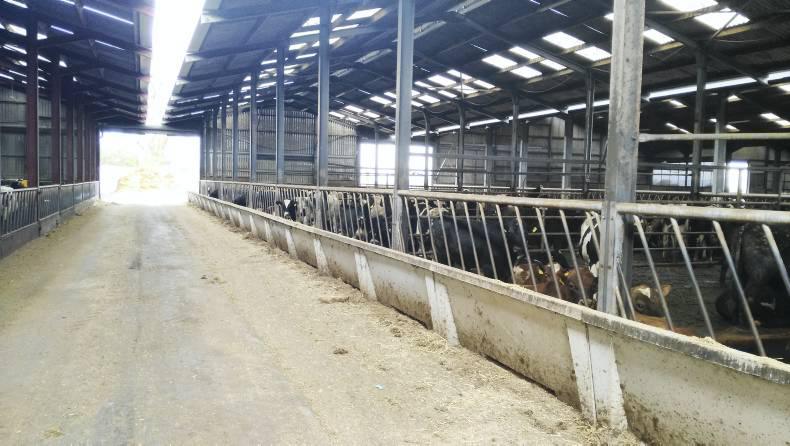Last week, the Irish Farmers Journal visited Synone farm, a very large dairy and beef finishing enterprise in Cashel, Co Tipperary.
There are 600 dairy cows on the farm comprising spring and winter milking herds. All of the male offspring from the herds are finished indoors as 22-month-old bulls and more bull calves are also bought in for feeding and finishing.
In 2006, a large 12-span shed was built specifically for finishing cattle. The shed can hold up to 240 bulls and is designed to be as labour-efficient as possible because time is not always in great supply on the busy farm, especially during peak calving periods.
The scale of the infrastructure on the farm is impressive and is a good example of how large finishers handle big numbers of stock. Despite the scale of the building featured in this article, average-sized beef finishers may be able to take some ideas away from the simple shed design and apply to their own farms.
Pictures one, two and three
Every morning, the bulls are fed with a diet feeder on both sides of the pens (passageways are at either side which allows a doubling of feedspace). They are fed a mix of barley, maize meal, beet and maize silage.
Special concrete “J” feed troughs supplied by Murphy Concrete Products Ltd were installed on one side of this shed because the farmer wanted to reduce the time spent pushing feed into cattle and he believes it is also helping to reduce waste.
“I feed very good quality forage which is a big factor in reducing waste, but I have noticed that since I put in the concrete feeders, there has been less waste than usual. You would need to have a tub feeder or forage wagon though to use the troughs properly,” the farmer says.
He believes that birds are less likely to fly into the feeders compared with when the feed is left loose in the shed. “Two barrow fulls worth of waste feed wouldn’t accumulate in the troughs in the space of a month, which partly comes down to the troughs and also having good quality feed,” explains the farmer.
John Murphy, manufacturer of the “J” trough, says that the troughs can be used in new builds and can also can be used in existing sheds. “The feed trough is designed with a curved back wall so that the feed will always fall towards the livestock. Two feed troughs will fit the common 4.8m span. The cost per span is approximately €400 excluding VAT and they can also be cut to suit if the shed had its last span shorter,” according to John.
He says that they are easy to fit and easy to remove because there is room for pallet forks underneath. “All precast concrete feed troughs are manufactured at our factory just outside Enniscorthy and are made from 40N self-compacting concrete. They are also steel reinforced,” John says.
The farmer buys grain directly off the combine and stores it in a large grain shed that was built last year (picture three). He buys in approximately 1,000 tonnes of barley, at less than 18% moisture at harvest time. A contractor rolls it and treats it with Home n’ Dry to ensure that it is preserved.
The farmer says that it takes less than half an hour to fill the forage wagon with the different ingredients and feed the 240 bulls in the sheds. Feeding is done once a day.
Picture four
The most striking feature of the shed when you enter is the scale and the height. The farmer wanted plenty of air flow to ensure that there was a healthy atmosphere for finishing stock. It is 24ft high at the apex and there is a non-drip fibre cement roof with a canopy at the apex.
There is also a gap between the sheds to allow more air movement.
All of the sheds on the farm were built in stages with this 12-span shed built beside a large cubicle shed in 2006. Another cubicle shed was built beside it in 2012 and this helped to shelter the side of the finishing shed from rain blowing in on top of cattle.
The farmer added roller doors at the central passage at one end of the shed to prevent drafts coming from the prevailing winds. With the good height and plenty of ventilation, the farmer says that the air in the shed doesn’t get warm from cattle in the summer, even with the large number being fed. The slurry storage is also impressive with an 8ft deep tank spanning the length of the shed and it is agitated via the external agitation points at either end.
Pictures five and six
Inside the pens, comfort and animal welfare is kept to the fore. All of the pens have slatted rubber mats because the farmer believes that no shed should be without rubber mats where stock are being finished.
“With the number of cattle being finished, without rubber mats we would always be taking cattle out with hurts and this would disrupt liveweight gain,” explains the farmer.
To reduce the incidence of lameness in the groups, each pen of bulls is run through a footbath once a week in the cattle crush. “We put them through a Formalin-based footbath once a week and a Bluestone-based footbath the following week,” the farmer says.
The farmer also takes drinking water hygiene seriously in the shed. All troughs have a tipping mechanism that allows the troughs to be cleaned out easily and they are tipped out regularly.






 This is a subscriber-only article
This is a subscriber-only article















SHARING OPTIONS: